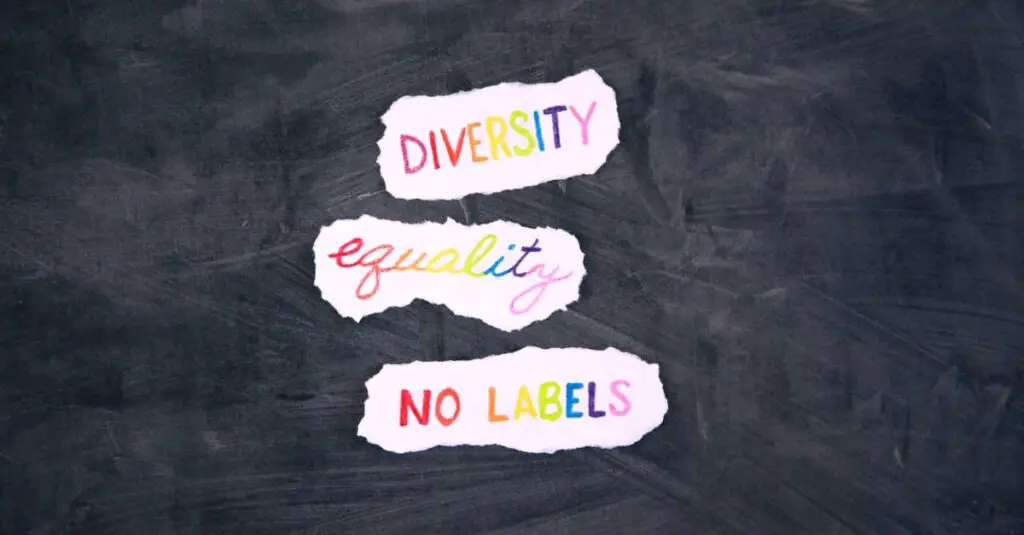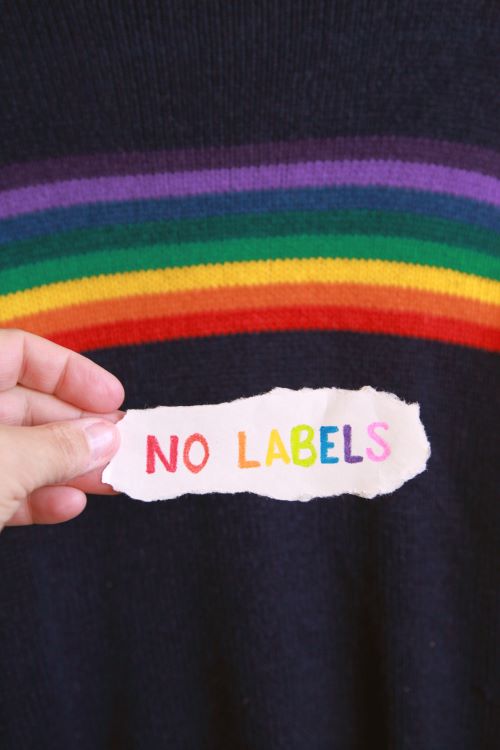Labels and Names: Why Labeling People Leads to Discrimination
We’re definitely in times where labeling people and their interests or beliefs seems like a popular thing to do.
Just look at all the articles that talk about a person’s age and generation (Gen Z, Gen Y, Boomers, and Karens, to cite a few), the polarized political system (no need to put all those out there here), or action groups like Woke, Cancel Culture, Right to Lifers, etc.
 Labels and names are all over social media and seem to go way beyond the more traditional ways of labeling people. Many (or most) seem divisive instead of establishing niches.
Labels and names are all over social media and seem to go way beyond the more traditional ways of labeling people. Many (or most) seem divisive instead of establishing niches.
Some of the most hurtful types of labeling people come in the form of gender, race, religion, immigrant status, mental health, a person’s size, beliefs, and of course, special education labels.
I’m the first to say that probably most of us are guilty of labeling people, and sometimes we put on labels and names as a way to organize groups or interests.
Labeling people, however, whether it is meant in an innocent or even positive way, seems to have become downright nasty and derogatory more often than not.
And that’s the type of behavior we should all try to stop.
Labeling People: Don’t Label Me and I Won’t Label You
The types of labels and names we are throwing on people have been the topic of many conversations around the dinner table and in social situations as we try and defend and explain why we think like we do.
It’s one thing to have opinions on various issue that affect our lives, and I think opinions and even healthy debates are extremely important. We all don’t want to live our lives without taking a stance on anything we care about, after all.
But at the same time, I don’t want to have an autism label or special education label put on me as a way to describe who I am, because I am way more than that. I’m a person with a lot of interests, passions, plans, and opportunities who also has autism.
Because my niche is talking about my journey of living a life with autism, I’ll start by focusing on autism labels and special education labels.
Labels and Names: The Positives of Special Education Labels
Labels and names can be both good and bad. They can help people better understand themselves and others but it can also lead to stigmatizing, or pathologization.
Did you know that the term “autism” was first used by Austrian American Psychiatrist and Physician Leo Kanner in 1943?
That doesn’t mean people didn’t have autism prior to then, and I’ve mentioned individuals like Mozart and Einstein as being thought to having it as well. However, it was the first time it had a specific label and name associated to the neurodevelopmental disorder we are familiar with today. 
According to research, Dr. Kanner expressed great concern about mistreatment of children he saw with mental disabilities, and noted specific behaviors as being different than other more common disorders.
This isn’t an autism history lesson, but the point is that since receiving a specific name and diagnosis, there have been many changes to the way autism is understood and diagnosed.
Through the years, autism and its special education label has shifted.
Rather than a diagnosis of “autism” it is now a diagnosis of “autism spectrum disorder” in recognition that autism is a spectrum with a very wide range of abilities and challenges.
The diagnosis of ASD also encompasses the special education label of “Asperger’s syndrome” as well.
Special Education Labels: Benefits of Labels for Autism
One of the primary benefits of assigning labels for autism is that it can help identify individuals who need support and provide appropriate interventions and assistance.
It can also help clinicians and caregivers understand a person’s strengths, challenges, and needs. It is the same for any of the special education labels used in education and therapy.
For example, a label of autism can help identify a child (or teen or adult) who struggles with social skills and communications and who may benefit from additional support or speech therapy.
It can also help individuals with autism understand why they have difficulty with certain tasks and help them get the help and support they need.
Using a label for autism can also provide access to resources and services that may not be otherwise be available.
Schools (both public and private) typically have programs specifically designed for students with autism, to provide the best overall educational experience possible.
Healthcare providers may have access to specialized treatments. For example, some individuals with autism may benefit from sensory integration therapy, which can help regulate responses to sensory input.
A label of autism can help individuals access this type of therapy.
Labels can also help raise awareness about autism and promote acceptance, understanding, and connections. They can help people understand that autism is a neurological difference and behaviors or actions are not a personal choice or character flaw.
A label for autism can help reduce stigma and promote inclusion. By understanding that autism is a spectrum, people can better appreciate the diversity of experiences and abilities of individuals with autism. But, it doesn’t always work that way.
Harmful Effects of Labeling People And Assigning Autism Label
While special education labels can be beneficial, they can also have drawbacks as well. One of the most significant drawbacks is the potential for stigmatization.
People with autism are often labeled as “different” or “disabled,” which can lead to negative attitudes and discrimination from others. Negative attitudes and discrimination can make it harder for individuals with autism to achieve their goals and find their place in society.
Labels can also limit our understanding of a person’s unique strengths, challenges, and needs. It can be easy to assume that all individuals with autism are the same, which can lead to a one-size-fits-all approach to treatment.
Every individual with autism is unique and has different strengths and challenges.
A label of autism should never overshadow an individual’s unique identity.
Labels and Names and How They Can Become Self-Fulfilling
Labels can also create a self-fulfilling prophecy, where individuals who receive certain labels, such as a label with autism, begin to see themselves as “different” or “disabled” and even start internalize negative attitudes from others.
This can lead to lower self-esteem and feelings of isolation, and begin to cause mental health concerns.
Individuals with autism can begin to view themselves in a negative light, which can limit their potential and lead to missed opportunities.
It is essential to understand that labels are not the whole story about a person. How would you like to be defined by a title of a book, for example, where no one thinks there is a need to open it and read a single page?
We all want to be defined by who we are and the actions we take, and not by a label. We are ALL humans, after all, and are unique.
Labels can be helpful in identifying individuals who may benefit from additional support, but they should not be used as a way to define an individual.
Every individual with autism is just that…an individual with autism. It is important to learn about and understand their specific needs and strengths.
How to Communicate Without Labeling People: Tips and Strategies
 Even before I started writing about my life with autism, I was aware of certain labels and how their use could define me.
Even before I started writing about my life with autism, I was aware of certain labels and how their use could define me.
While I was unaware of labels as a child, I did realize that even well-intentioned labels describing me made me at times stand out and be different.
Of course we are all going to use descriptions about people in general, but some of the ones given to me certainly pointed the way back to labels for autism.
I was always “extremely organized” and “highly focused” on topics that interested me, for example.
To help with the understanding of labels and how they can be useful or harmful depending on the circumstances, I want to throw some out here. These are ones that I have learned (and individuals have commented to me) and show that there are better ways to explain having autism than sometimes used.
Here are some things I have learned.
Say or Use This, Not That When it Comes to Labeling People
- Use “Autism Spectrum Disorder (ASD)” rather than “autism” when appropriate. The reasoning here is that it better explains that the disorder falls on a huge spectrum of abilities and that everyone is unique.
Having said that, I will admit I freely use the word “autism” instead of ASD because the second one is a mouthful when said in full.
And when I say ASD, people don’t know what I’m talking about. But I also say, “on the spectrum” and individuals seem to understand and appreciate that.
- Use the term “low support needs” “high functioning.” It’s one thing to have the label high functioning, but how would you feel if you receive the label of “low functioning?”
Not very good I would imagine. In a world with challenges, we should do things to build one another up. And, many argue that we don’t need to say this at all.
- “Asperger’s syndrome” is a term that is dated. I agree and disagree at the same time. It has been explained to me that if you received this diagnosis then you may prefer to stick with it, and not switch to ASD when you feel a need to identify.
The point is that it now falls under the spectrum and isn’t separate. I was also on the bubble year of 2013 when I was diagnosed and told I had “Asperger’s syndrome” but that it now fell under the more comprehensive description of ASD.
- Avoid the puzzle piece icon associated with autism. This is one where I can understand both sides. I think a child might relate better to a colorful puzzle piece but it is also seen as stigmatizing.
The puzzle piece is meant to signify the complexity of the autism spectrum.
However, many people believe that it is infantilizing and promotes the belief that individuals with autism are somehow missing puzzle pieces or are incomplete or that the behaviors that may come with being autistic are “puzzling.”
Some are now using the rainbow infinity loop for diversity instead.
I personally like the saying where autistic people say, “People, not puzzles.”
- Don’t get hung up on whether to say person first, whether someone “has” something, or describing the disorder first. People get all defensive about whether to say autistic person, a person with autism, or a person who has autism (feel free to substitute any disorder here instead of “autism”).
The point is that if the label needs to be used, make sure it is used for a positive purpose. Or don’t use it at all.
- Don’t call me “disabled.” I am “enabled” to live my life to the fullest … with autism. And I am indeed “special” but only in a positive way, so don’t use it as a way to label me in any way that makes it appear I am “less than.” I may be different, but I am definitely not less than anyone else.
Additional Misconceptions That Lead To Autism Stigmas and Stereotypes
Learn more about other stigmas and stereotypes that autistics face:
- Autism Media Stereotypes: We’re Not All Geniuses, Savants, or Lonely
- Beyond Stereotypes: How Rain Man Revolutionized the Perception of Autism
- Absurd Plot About Autism and Evolution and Why It’s Harmful
- Moving Past the Tired Conspiracy Theory of Vaccines and Autism
- Discover the Powerful Bond Between Autism and Pets
- 3 Reasons Why Pathologizing Crushes Autism Acceptance and Inclusion
- The Hidden Hurdles: Challenging Autism Stigmas in Today’s Politics
- History of Autism: Revealing Shocking Mysteries from the Past
- Knocking Down the Stigma to Autism Obsession